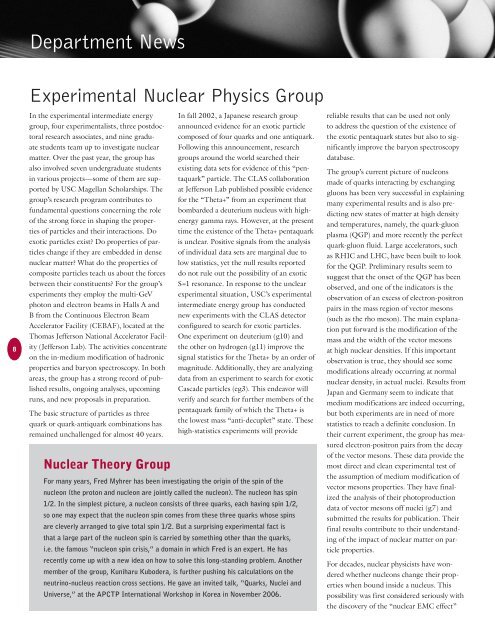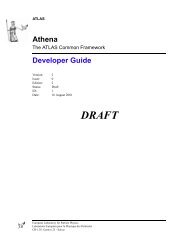2007 - Physics and Astronomy - University of South Carolina
2007 - Physics and Astronomy - University of South Carolina
2007 - Physics and Astronomy - University of South Carolina
You also want an ePaper? Increase the reach of your titles
YUMPU automatically turns print PDFs into web optimized ePapers that Google loves.
Department News<br />
<br />
Experimental Nuclear <strong>Physics</strong> Group<br />
In the experimental intermediate energy<br />
group, four experimentalists, three postdoctoral<br />
research associates, <strong>and</strong> nine graduate<br />
students team up to investigate nuclear<br />
matter. Over the past year, the group has<br />
also involved seven undergraduate students<br />
in various projects—some <strong>of</strong> them are supported<br />
by USC Magellan Scholarships. The<br />
group’s research program contributes to<br />
fundamental questions concerning the role<br />
<strong>of</strong> the strong force in shaping the properties<br />
<strong>of</strong> particles <strong>and</strong> their interactions. Do<br />
exotic particles exist? Do properties <strong>of</strong> particles<br />
change if they are embedded in dense<br />
nuclear matter? What do the properties <strong>of</strong><br />
composite particles teach us about the forces<br />
between their constituents? For the group’s<br />
experiments they employ the multi-GeV<br />
photon <strong>and</strong> electron beams in Halls A <strong>and</strong><br />
B from the Continuous Electron Beam<br />
Accelerator Facility (CEBAF), located at the<br />
Thomas Jefferson National Accelerator Facility<br />
(Jefferson Lab). The activities concentrate<br />
on the in-medium modification <strong>of</strong> hadronic<br />
properties <strong>and</strong> baryon spectroscopy. In both<br />
areas, the group has a strong record <strong>of</strong> published<br />
results, ongoing analyses, upcoming<br />
runs, <strong>and</strong> new proposals in preparation.<br />
The basic structure <strong>of</strong> particles as three<br />
quark or quark-antiquark combinations has<br />
remained unchallenged for almost 40 years.<br />
Nuclear Theory Group<br />
In fall 2002, a Japanese research group<br />
announced evidence for an exotic particle<br />
composed <strong>of</strong> four quarks <strong>and</strong> one antiquark.<br />
Following this announcement, research<br />
groups around the world searched their<br />
existing data sets for evidence <strong>of</strong> this “pentaquark”<br />
particle. The CLAS collaboration<br />
at Jefferson Lab published possible evidence<br />
for the “Theta+” from an experiment that<br />
bombarded a deuterium nucleus with highenergy<br />
gamma rays. However, at the present<br />
time the existence <strong>of</strong> the Theta+ pentaquark<br />
is unclear. Positive signals from the analysis<br />
<strong>of</strong> individual data sets are marginal due to<br />
low statistics, yet the null results reported<br />
do not rule out the possibility <strong>of</strong> an exotic<br />
S=1 resonance. In response to the unclear<br />
experimental situation, USC’s experimental<br />
intermediate energy group has conducted<br />
new experiments with the CLAS detector<br />
configured to search for exotic particles.<br />
One experiment on deuterium (g10) <strong>and</strong><br />
the other on hydrogen (g11) improve the<br />
signal statistics for the Theta+ by an order <strong>of</strong><br />
magnitude. Additionally, they are analyzing<br />
data from an experiment to search for exotic<br />
Cascade particles (eg3). This endeavor will<br />
verify <strong>and</strong> search for further members <strong>of</strong> the<br />
pentaquark family <strong>of</strong> which the Theta+ is<br />
the lowest mass “anti-decuplet” state. These<br />
high-statistics experiments will provide<br />
For many years, Fred Myhrer has been investigating the origin <strong>of</strong> the spin <strong>of</strong> the<br />
nucleon (the proton <strong>and</strong> nucleon are jointly called the nucleon). The nucleon has spin<br />
1/2. In the simplest picture, a nucleon consists <strong>of</strong> three quarks, each having spin 1/2,<br />
so one may expect that the nucleon spin comes from these three quarks whose spins<br />
are cleverly arranged to give total spin 1/2. But a surprising experimental fact is<br />
that a large part <strong>of</strong> the nucleon spin is carried by something other than the quarks,<br />
i.e. the famous “nucleon spin crisis,” a domain in which Fred is an expert. He has<br />
recently come up with a new idea on how to solve this long-st<strong>and</strong>ing problem. Another<br />
member <strong>of</strong> the group, Kuniharu Kubodera, is further pushing his calculations on the<br />
neutrino-nucleus reaction cross sections. He gave an invited talk, “Quarks, Nuclei <strong>and</strong><br />
Universe,” at the APCTP International Workshop in Korea in November 2006.<br />
reliable results that can be used not only<br />
to address the question <strong>of</strong> the existence <strong>of</strong><br />
the exotic pentaquark states but also to significantly<br />
improve the baryon spectroscopy<br />
database.<br />
The group’s current picture <strong>of</strong> nucleons<br />
made <strong>of</strong> quarks interacting by exchanging<br />
gluons has been very successful in explaining<br />
many experimental results <strong>and</strong> is also predicting<br />
new states <strong>of</strong> matter at high density<br />
<strong>and</strong> temperatures, namely, the quark-gluon<br />
plasma (QGP) <strong>and</strong> more recently the perfect<br />
quark-gluon fluid. Large accelerators, such<br />
as RHIC <strong>and</strong> LHC, have been built to look<br />
for the QGP. Preliminary results seem to<br />
suggest that the onset <strong>of</strong> the QGP has been<br />
observed, <strong>and</strong> one <strong>of</strong> the indicators is the<br />
observation <strong>of</strong> an excess <strong>of</strong> electron-positron<br />
pairs in the mass region <strong>of</strong> vector mesons<br />
(such as the rho meson). The main explanation<br />
put forward is the modification <strong>of</strong> the<br />
mass <strong>and</strong> the width <strong>of</strong> the vector mesons<br />
at high nuclear densities. If this important<br />
observation is true, they should see some<br />
modifications already occurring at normal<br />
nuclear density, in actual nuclei. Results from<br />
Japan <strong>and</strong> Germany seem to indicate that<br />
medium modifications are indeed occurring,<br />
but both experiments are in need <strong>of</strong> more<br />
statistics to reach a definite conclusion. In<br />
their current experiment, the group has measured<br />
electron-positron pairs from the decay<br />
<strong>of</strong> the vector mesons. These data provide the<br />
most direct <strong>and</strong> clean experimental test <strong>of</strong><br />
the assumption <strong>of</strong> medium modification <strong>of</strong><br />
vector mesons properties. They have finalized<br />
the analysis <strong>of</strong> their photoproduction<br />
data <strong>of</strong> vector mesons <strong>of</strong>f nuclei (g7) <strong>and</strong><br />
submitted the results for publication. Their<br />
final results contribute to their underst<strong>and</strong>ing<br />
<strong>of</strong> the impact <strong>of</strong> nuclear matter on particle<br />
properties.<br />
For decades, nuclear physicists have wondered<br />
whether nucleons change their properties<br />
when bound inside a nucleus. This<br />
possibility was first considered seriously with<br />
the discovery <strong>of</strong> the “nuclear EMC effect”
















